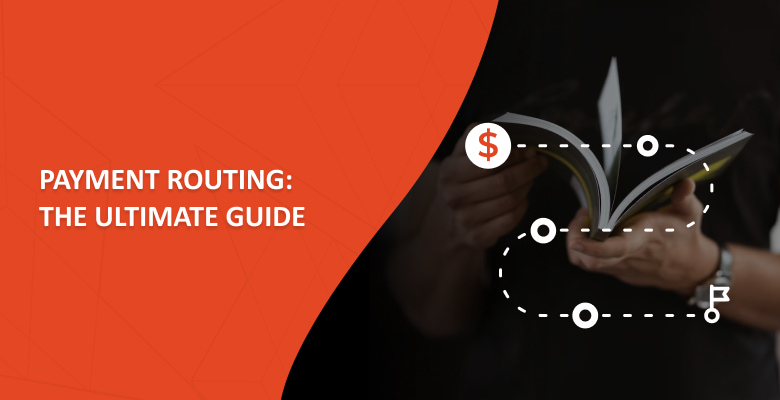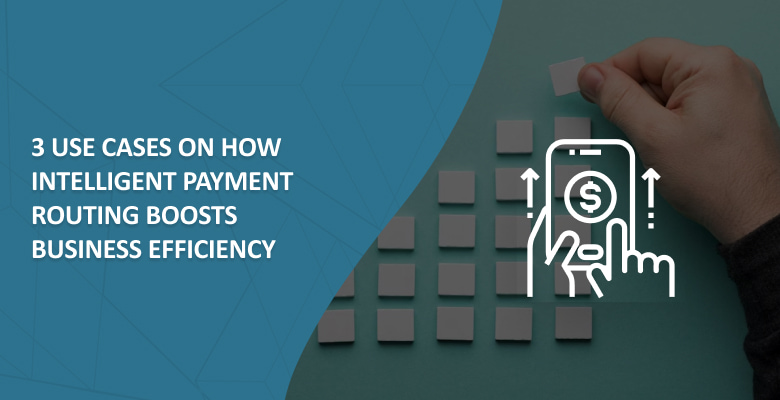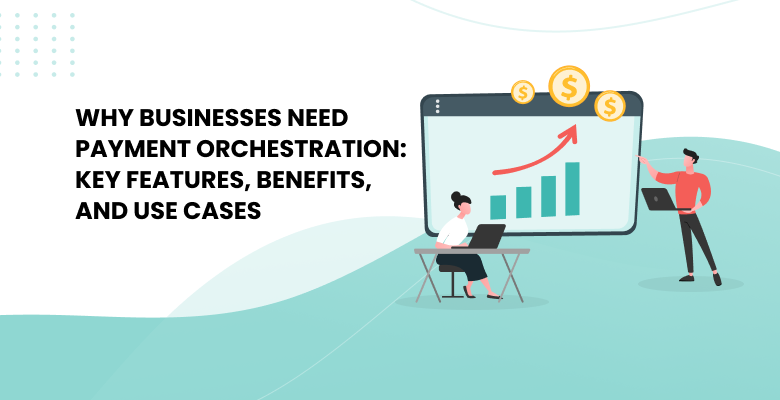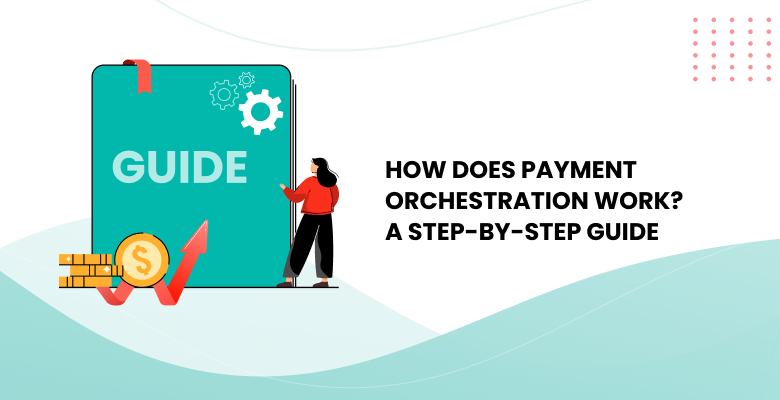
Nothing hurts payment performance more than operational drag. If you struggle with fragmented PSP integrations, compliance risks, and high maintenance costs, you need to rethink your payment setup. Forward-thinking merchants adopt payment orchestration to simplify complexity and future-proof their operations.
So, how does payment orchestration work to solve these challenges? Payment orchestration is a middleware that connects multiple PSPs, APMs, and gateways through a single API. With this solution, merchants gain flexibility, optimized routing, reporting and analytics, fraud management, and other helpful tools on one platform.
In this article, we’ll show you how payment orchestration works, explain the process behind it, and discuss its importance for scaling businesses.
How Does Payment Orchestration Work?
To explain how a payment orchestration platform typically works, let’s define the term first. Orchestration involves using software that bridges merchants with various PSPs and payment methods through a single API, simplifying payment management with advanced tools and technologies.
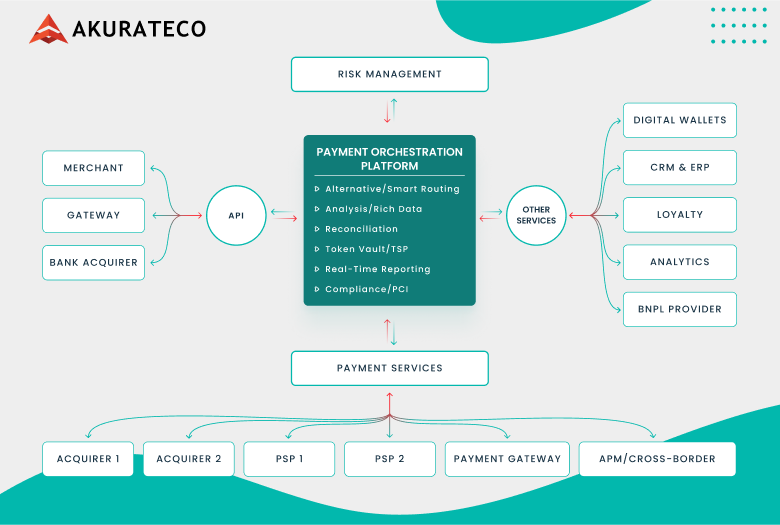
Several crucial components of payment orchestration make it possible to unify, automate, and optimize the entire payment flow:
- Integration. Establishes unified access to multiple PSPs, acquirers, APMs, and other third-party services, like digital wallets, CRM/ERP, loyalty systems, analytics, and BNPL providers. It consolidates your payments, providing full visibility on each provider, transaction, acquirer, and integration.
- Orchestration logic. For transaction optimization, smart routing directs each payment to the best-performing provider (acquirer, PSP, gateway, or APM) based on cost, region, or success rate. Cascading reroutes declined transactions from one payment provider to another, as many as needed within one payment attempt.
- Security and compliance. Enforces compliance with global standards (PCI DSS, GDPR, and PSD2) and includes tokenization, third-party scoring, and AI-based fraud prevention.
- Analytics. Unifies data across all payments and offers real-time dashboards, reconciliation, and reporting tools, reducing manual work and delivering data-driven insights into customer behaviors and preferences, and possible improvements.
- Merchant experience. Self-service tools and automation enable merchants to configure settings, providing full control over payment strategy.
To understand the real value of this technology, it’s essential to see it in action. How does payment orchestration work step by step when a customer makes a payment?
- Transaction initiation. A customer goes to the checkout, chooses the preferred payment method.
- Card details checks. This process includes cardholder verification and security checks.
- Gateway selection. At this stage, a payment orchestration platform carefully determines the best-performing gateway for transaction processing.
- Smart routing. Based on the logic used by the merchant, a platform directs a transaction to the best available gateway in real-time.
- Cascading. Declined transactions are automatically sent quickly from one payment provider to another, as many as needed within one payment attempt.
- Acceptance. When a payment receives approval, the acquiring bank confirms it and communicates the authorization to the payment gateway and the merchant.
- Settlement and reconciliation. Payment orchestration consolidates transaction data from multiple providers, matches settlements, and generates unified reports.
Just as this term’s name suggests, payment orchestration coordinates every stage of the digital payment flow. As a result, you benefit from optimized success rates and minimized operational complexity.
How Orchestration Simplifies Work Across Teams
While orchestration streamlines payments, it also empowers your teams to gain efficiency, alignment, and the insight to optimize performance across the entire payment lifecycle:
- Payment and support teams. Orchestration offers a unified platform for connecting all the necessary PSPs, gateways, payment methods, acquirers, and other integrations. This enables faster rollout and testing of new payment methods through a single dashboard.
- Development teams. With orchestration, merchants get access to one API integration instead of managing multiple PSP connections separately.
- Operations teams. If your teams have to handle manual spreadsheets across multiple PSPs, orchestration can help with centralized, automated reporting. The benefits are clear: saved hours of reconciliation time and reduced errors.
- QA teams. Orchestration standardizes checkout flows and streamlines testing across providers. This results in fewer variations, faster validation, and higher reliability
With a coordinated payment orchestration infrastructure, businesses can significantly improve their payments while enabling aligned cross-team collaboration and operational agility.
Our experience speaks for itself — a recent case proved how payment orchestration can significantly boost efficiency. One merchant was struggling with long and complex integrations for months. By transitioning from fragmented multi-PSP management to a unified orchestration layer, they significantly shortened integration timelines to just a few weeks, shares Anastasia Brener, a CCO of Akurateco.
How Orchestration Maximizes Performance?
How a payment orchestration platform typically works can be summed up in one goal: improving performance within your payment ecosystem through optimized routing, automation, and centralized control.
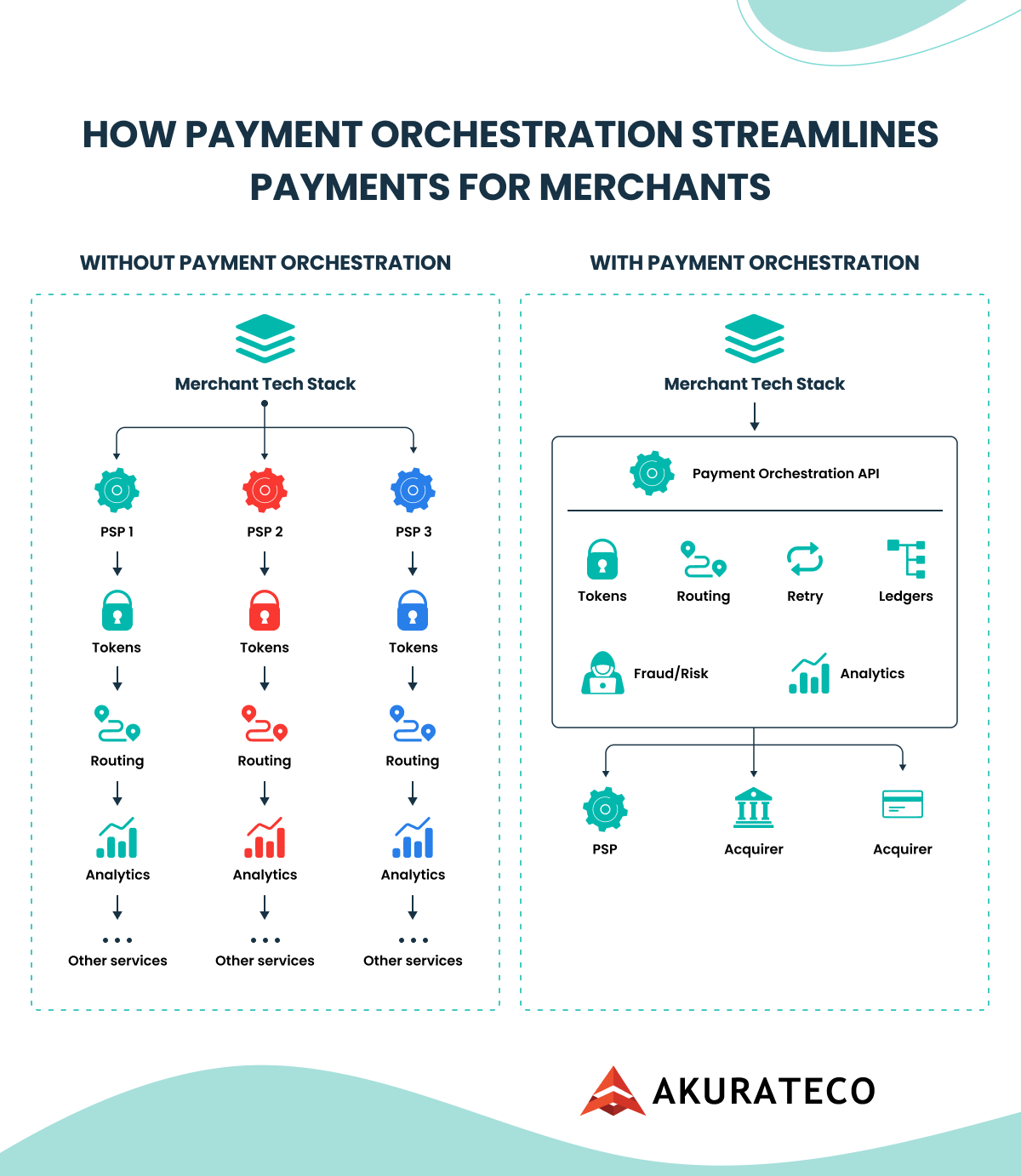
The platform integrates multiple PSPs, acquirers, gateways, and payment methods into one hub. Then, it applies smart logic, such as routing and cascading, to ensure better approval rates and conversion, thereby enhancing customer experience.
With built-in analytics, settlement, and compliance controls in a monitoring system, you can ensure consistent performance across all regions. Anti-fraud measures and tokenization guarantee the utmost level of security. Scaling with these tools becomes seamless.
Together, these features boost performance by delivering higher approval rates, smoother checkout, and simplified global operations. For instance, Akurateco’s clients have seen an increase in approvals by up to 30% and reduced processing costs up to 25%.
Signs You Need Payment Orchestration
Payment orchestration helps with different use cases, especially if you’re a growing merchant, a payment service provider, or an organization scaling globally and needing centralized control over multiple PSPs. All these businesses share similar challenges. If you relate to the following problems with efficiency, costs, customer satisfaction, and growth, you’re clearly in need of a payment orchestration layer that eliminates complexity and boosts performance.
Difficulties in managing several PSPs
If your business relies on three PSPs, let alone more, you already know the pains of fragmented data about each provider, a lack of reporting, and compliance challenges. By using orchestration, you can unify all these processes in one place, while built-in advanced technologies and tools improve your payment flow at every stage.
Increasing payment failure rates
A high payment acceptance rate means you receive all your payments successfully and can grow your business predictably. If you don’t share this experience and constantly struggle with low payment success rates, you’re losing customer trust, revenue, and control over your costs. Orchestration optimizes transaction processing through dynamic routing, directing each payment to the best-performing provider based on success rate, fees, and location.
Processing costs are eating into profits
If you rely only on a few PSPs, you’re stuck with their fees, terms, and performance limits. This really cuts into your revenue and makes scaling impossible. Orchestration gives you many options, so you can balance cost, performance, and reliability across multiple providers.
Ensuring compliance feels like a constant battle
Every business must be compliant with local regulations. High-risk industries, like entertainment, pharmaceuticals, and travel, are especially pressured with compliance requirements. One missed requirement can mean suspension or even a full ban. Payment orchestration simplifies this process and automates compliance workflows.
How Akurateco Helped Retail to Manage Global Payments and Scale Efficiently
Recently, we have worked with a mid-sized retail client that faced common problems with their payments:
- PSPs from different locations scattered across different dashboards without a unified dashboard.
- An increasing number of payment failure rates.
- Processing costs cutting into revenue.
- Lack of reliable security measures and PCI DSS compliance complexity.
Managing payments in that situation was impossible, let alone scaling or operating efficiently. We suggested moving to payment orchestration — the one solution that checked every box: frictionless processing, smarter routing, hassle-free compliance, and seamless scalability.
As a result, orchestration helped retail handle global payment and laid a solid foundation for future-proof growth by delivering the following benefits:
- A unified system for all integrations, global and local, out of our existing 600+ connectors.
- A dashboard with a monitoring system for analytics, reporting, and tracking.
- Intelligent routing and cascading not only stopped the cycle of failed payments but also helped the client achieve a 30% increase in approvals.
- Reduced processing costs by 25% enabled the client to finally move on from maintenance to investing in growth.
- Automated security and compliance workflows, ensuring continuous adherence to PCI DSS, anti-fraud measures, and tokenization.
By consolidating all payment operations into a single orchestration platform, our retail client moved from chaos to clarity. Today, they process payments globally with confidence, ready to scale into any market seamlessly.
Why Choose Akurateco’s Payment Orchestrion Platform
Akurateco’s payment orchestration platform helps businesses simplify management and scale globally with the following robust stack of features and tools:
- Over 600+ integrated banks and payment providers that support a wide range of traditional and alternative payment methods.
- Custom connections can be developed upon request at any time of deployment.
- Up to 30% increase in approval rates through intelligent routing and cascading.
- Payment Team as a Service model offers continuous support, monitoring, and troubleshooting tailored to your business operations.
- PCI DSS Level 1 certification, anti-fraud modules, and integrations with leading risk-scoring partners such as Fraudio, MaxMind, and AcuityTec.
- Data-driven decision-making tools, featuring advanced analytics and open API access for custom reporting.
Conclusion
So, how does payment orchestration work, and what value does it bring to merchants? Payment orchestration is about using software to create a network of multiple PSPs, APMs, and gateways. It intelligently manages transaction routing, cascading retries, fraud screening, and real-time analytics and reporting.
The significant benefit of such a solution is that you can access all this data in a single, centralized system. As a result, this payment ecosystem supports efficiency at every stage of your payment lifecycle, helping you scale faster and smarter.
FAQ
How does payment orchestration work, and does it replace a PSP or work alongside them?
Payment orchestration is the process of using software to connect multiple PSPs through a single API, managing routing, retries, and reporting in one place. Thus, it doesn’t replace PSPs, but works alongside them to simplify payment management and boost performance with the entire workflow.
What systems can a payment orchestration platform integrate with besides PSPs?
Aside from core integrations with PSPs and gateways, payment orchestration platforms have other connections that help create a unified system. This includes CRMs and ERPs, fraud prevention, risk-scoring tools, accounting, and reconciliation. In addition, there’s software for optimizing transactions, such as routing and cascading.
How long does it typically take to implement a payment orchestration platform?
The payment orchestration process takes from a few weeks to a few months. But the exact timeline depends on the complexity of integrations and customization required. In payment orchestration companies like Akurateco, you can expect a full setup in a week. Additional integrations may take more time, up to two weeks.
What reporting and analytics features are usually included in orchestration platforms?
Payment orchestration providers offer a number of helpful analytics tools. This typically includes real-time transaction tracking, PSP performance, approval rates, and cost analysis. Dashboards often include dispute tracking, reconciliation, and data exports.
How does payment orchestration help with cross-border payments and multi-currency support?
The payments orchestration layer applies intelligent logic supported by routing to ensure successful global payments. Based on predefined criteria, including geography, fees, and other factors, the platform automatically selects the best-performing provider for each transaction.


